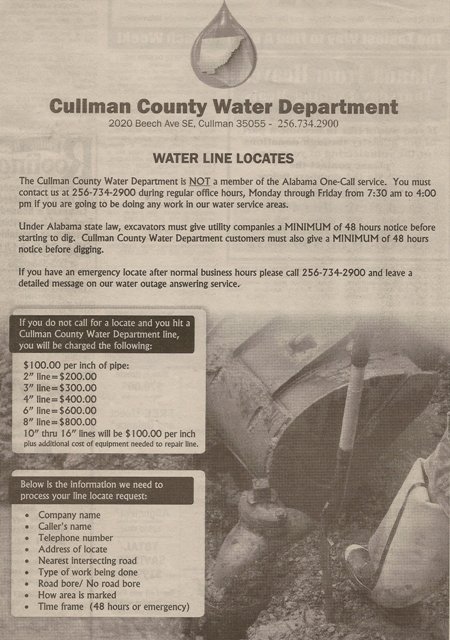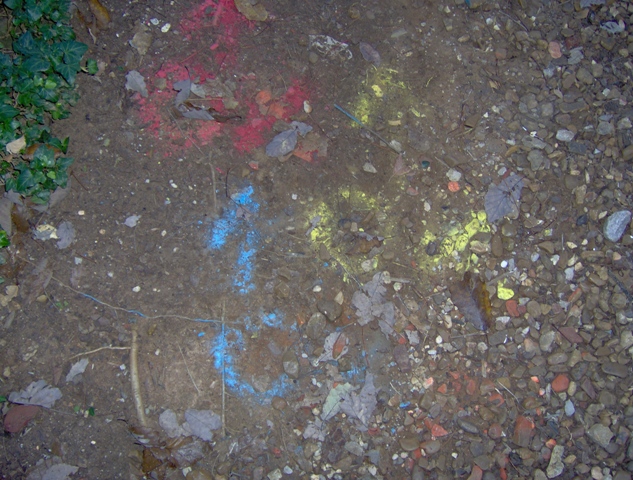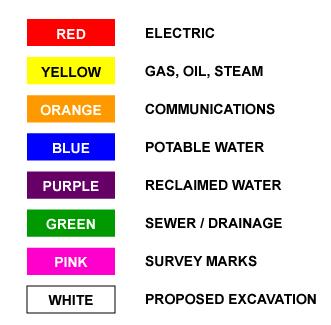 Last Sunday as I was driving into town – there sat the water company fixing a water main break on one of the back roads. At the time I didn’t think much about it (except for feeling a little sorry for them), until this ad ran in the local papers not 3 days later. It was simply reminding everyone that they must call and give at least 48 hours notice before digging. After doing a little bit of research, I was shocked to learn that there were at least 135,621 incidents in 2008 alone. (Common Ground Alliance)
Last Sunday as I was driving into town – there sat the water company fixing a water main break on one of the back roads. At the time I didn’t think much about it (except for feeling a little sorry for them), until this ad ran in the local papers not 3 days later. It was simply reminding everyone that they must call and give at least 48 hours notice before digging. After doing a little bit of research, I was shocked to learn that there were at least 135,621 incidents in 2008 alone. (Common Ground Alliance)
Call 811 before digging:
 Out of all those reported, 9% or 12,554 of them were related to Home Owners and Farmers, with the bulk issue being, they never called to get the lines marked. Fortunately, the good old days of calling each utility up & waiting at least a week for them to mark their lines (and hopefully in the right area) are long gone. Back in 2002, the Pipeline Safety Improvement Act was signed and amoung one of its many requirements was that a Nationwide Toll-Free Number be set up. On May 2007, the 8-1-1 system was implemented and is now in use nationwide. I have used the new number a few times, and on average, it only takes a few minutes and the lines are marked that day or early the next one. (In Alabama, they have 48 hours to mark them)
Out of all those reported, 9% or 12,554 of them were related to Home Owners and Farmers, with the bulk issue being, they never called to get the lines marked. Fortunately, the good old days of calling each utility up & waiting at least a week for them to mark their lines (and hopefully in the right area) are long gone. Back in 2002, the Pipeline Safety Improvement Act was signed and amoung one of its many requirements was that a Nationwide Toll-Free Number be set up. On May 2007, the 8-1-1 system was implemented and is now in use nationwide. I have used the new number a few times, and on average, it only takes a few minutes and the lines are marked that day or early the next one. (In Alabama, they have 48 hours to mark them)
Color Codes:
 While this picture is not the best, you can easily see three sets of markings that are red (Electric), blue (Water) & yellow (Gas). If you look real hard (bottom right), you might be able to also spot the fourth orange (Communication) mark also. Based on where we were working, they simply drew an arrow, and wrote OK to signify that none of their lines happened to be in that area.
While this picture is not the best, you can easily see three sets of markings that are red (Electric), blue (Water) & yellow (Gas). If you look real hard (bottom right), you might be able to also spot the fourth orange (Communication) mark also. Based on where we were working, they simply drew an arrow, and wrote OK to signify that none of their lines happened to be in that area.
Some common sense reminders:
- First & foremost – make sure you call 8-1-1, as it is a law in many states. Besides that, failing to call them can cost you a serious chunk of change, and possibly your life if you hit a line. Cost is not an issue in this case, it is a free call and does not cost you or the contractor a cent to get the lines marked.
- Make sure all possible utilities have marked their lines as shown above. While most states, utilities, etc… have jumped fully on board this system, there are still a few backwards one out there still. Unfortunately, Alabama happens to be one of those but the Call Center operators will generally inform you of any utilities you may have to call based on the address like the Cullman County Water Board…
- If you are digging where a utility was marked, you need to remember that the line they marked does not generally specify the exact location. In Alabama, they have a 3’ tolerance zone – i.e. 18” on both sides of the pipe. Each state can and does vary – as I recall Arizona’s is a 2’ zone.
- Don’t assume that just because code says a utility line should be down 12”, 16”, or 24” that it is – I have come across plenty of electric, gas & water lines that have only been under 4” to 6” worth of dirt (i.e. they can easily be hit if you are planting a shrub or tree)
- Along the don’t assume line – don’t assume that if nothing is listed, nothing is there – most septic lines, sprinkler lines, low voltage lines, or lines not installed by the utilities are not listed on the maps or marked. Nothing can ruin your day quicker than finding an unmarked gas line, that a previous homeowner installed to a backyard grill that is still active with no shutoff (Can you say Change Order and a few quick phone calls).
Additional Web Sites & Information:
- Tool Box Talk: OSHA & Excavation Safety – a “quick” overview of some applicable regulations
- List of State specific websites & numbers for one-call / dig-safe programs (includes Canada)
- Alabama 8-1-1 – list of member utilities


Good reminder…I need to re-grade around parts of my foundation, and even though (I think) I know where everything runs, I’ll be checking-in with the 811 system.
Good reminder…I need to re-grade around parts of my foundation, and even though (I think) I know where everything runs, I’ll be checking-in with the 811 system.